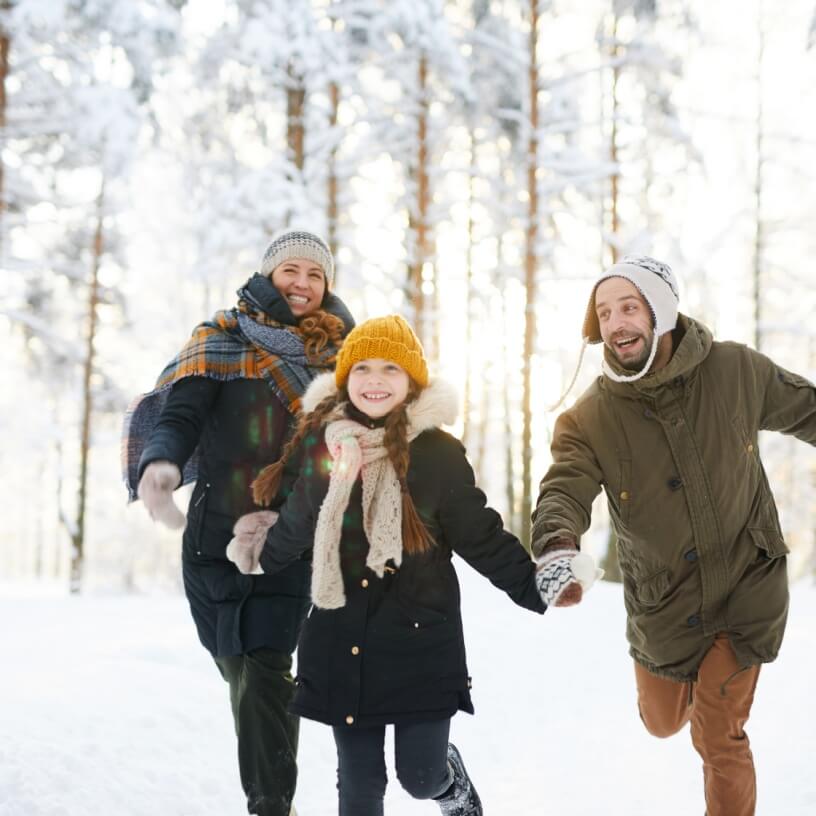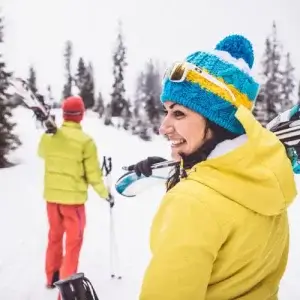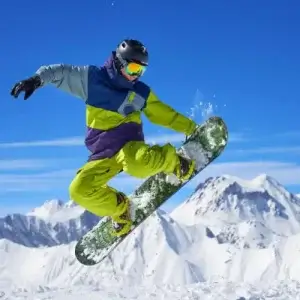Home / Compare Travel Insurance / Travel insurance for ski…

Key takeaways
Snow holidays are some of the most incredible experiences travellers can have. However, accidents are common when skiing and snowboarding, so we’ve put together a few things you should know about getting cover for snow-based activities:
- Losses related to snow sports (such as skiing or snowboarding) may not be covered automatically, and you may need to purchase cover as an optional extra.
- Some travel insurance with ski cover may only cover you for on-piste (marked) trails and ski runs.
- If you’re skiing in Australia, a domestic travel insurance policy may cover some winter sports related losses, but it won’t cover medical expenses (that’s what Medicare and your health insurance are for).
Why take out travel insurance with ski cover?
Taking out a travel insurance policy with ski cover is a good idea for any traveller looking to hit the slopes to give you peace of mind on your adventures. A few ways your policy might help include:
- If you have any on-piste injuries, your policy may cover emergency medical evacuation, as well as any hospital expenses.
- Reimbursing you for unused lift passes, skiing lessons and equipment hire if bad weather causes piste closures that stop you from being able to ski.
- Depending on your level of cover, your policy can also cover events unrelated to skiing, including lost or stolen baggage, unexpected cancellations costs, personal liability and more.
Choosing travel insurance with ski cover
Before you head to the slopes, it’s important to make sure you’re protected with a suitable level of cover. To help you travel with confidence, you should consider doing the following:
- Check what your policy covers automatically and if you need to purchase additional cover for skiing and snowboarding, as well as any other adventure sports activities you might have planned.
- Not all policies will cover off-piste skiing (also known as backcountry skiing), so if that’s something you plan to do, be sure to check that your insurer will cover you.
- Read the policy wording of the Product Disclosure Statement (PDS) and Target Market Determination (TMD) before taking out a policy to understand the extent of your cover (including any exclusions, limits or sub-limits) and whether it’s right for you.
Expert tips for choosing the right travel insurance for skiing and snowboarding
Our Executive General Manager of General Insurance, Adrian Taylor, has some tips for choosing suitable travel insurance with ski cover that suits your ski holiday’s needs.

Ski cover varies between insurers
Skiing and snowboarding cover differs greatly between insurers; for example, some will provide cover automatically while others will require an extra premium for the additional cover you need. Always check the PDS to make sure you have the right cover for your holiday plans.
Consider what cover you need for your entire trip
Think about the cover you need for your whole trip, not just while skiing. This may include cover for medical expenses, cancellation fees, luggage and any rental vehicle excess, but also the additional cover you need for your ski holiday. You need to keep all this in mind when searching for a policy that suits your holiday needs.
Make sure your belongings are protected
Don’t leave your possessions unattended in a public place, as any theft claims your make for these scenarios may be rejected. All policies have limits, conditions and exclusions to their cover, and you need to understand these to ensure you’re insured for everything you need.
All about winter sports cover
Do I need travel insurance with skiing and snowboarding cover?

Unlike many other travel options, ski and snowboarding cover is made for specific activities.
For those considering winter travel to participate in snow sports such as skiing, snowboarding or even snowmobiling, travel insurance can be crucial. If you choose not to take out ski trip cover before departing on your trip, you could be paying thousands out of pocket if things go wrong.
How does ski and snowboard insurance differ from standard travel insurance?
Standard travel insurance policies are a must-have when trekking anywhere across the globe. They can cover medical expenses, cancelled flights and other emergency costs, plus your personal effects and travel documents if they get lost or stolen.
A travel insurance policy that covers ski trips and snow sports includes these standard benefits (subject to a specific policy) but also cover for snow sport-related activities, since regular travel insurance doesn’t generally cover these. So, while you’re visiting the ski slopes, a policy that covers snow sports will give you the additional cover you may need.
However, travel insurance covering snow sports generally costs more than standard travel cover policies, as ski cover is typically an optional extra that you pay to add to a travel insurance policy.
What’s the best ski and snow sports travel insurance?
There are many different travel insurance policies to choose from, including those with add-on cover for snowboarding, skiing and winter sports. So, there’s no single ‘best’ travel insurance policy for a ski trip.
The key to finding the ‘best’ insurance for your needs is to see what’s listed in the PDS and to make sure you’re covered for the things you want, such as insurance cover for delays, cancellations, other adventure sports and your belongings.
Inclusions and exclusions
What does ski and snowboard insurance include?

Here are a few additional scenarios that may be included if you add-on ski pack to your travel insurance cover:
- Medical/Emergency rescue. Skiing and snowboarding can be exhilarating, but if you get injured while on the slopes, both the emergency medical evacuation to the hospital and subsequent medical costs could set you back thousands of dollars. Some ski trip travel insurance policies may cover these expenses, which could help take the worry away while you’re having fun on the mountains.
- Accidental equipment damage, theft or loss. There’s always a chance that the equipment you use may be damaged accidentally, stolen or lost in transit. Your travel insurance policy with snow sports cover should help pay for the repairs or replacement of both hired gear and your own equipment. Just keep in mind that travel insurance doesn’t cover damage to ski equipment when it was in use, if it was left unattended or left behind on transport.
- Unused equipment and passes. If you’re unable to use hired equipment you’ve paid for, pre-paid ski or snowboard lessons or lift passes due to sickness, injury or a lost or stolen pass, your policy may reimburse you.
- Closure due to weather conditions. While these destinations need snowfall to be operational, sometimes the weather can get a bit out of hand. If a ski field is closed due to poor weather conditions or other incident (e.g. a power failure preventing the lifts from working), your policy could cover some of your additional expenses, like those to travel to the nearest resort and the cost of more lift passes.
Please note that policies generally have caps on how much they cover for each scenario. Consider reading the PDS for the full details on what’s covered.
What does snow trip travel insurance exclude?
Before you purchase your snow trip policy, it’s important to check the PDS for a list of exclusions (events that your insurance won’t cover). While these can differ from insurer to insurer, here are a few instances that most travel insurance policies won’t cover when it comes to ski trips:
- Travelling to snow destinations outside of the season. It may be tempting to avoid the seasonal rush and go to the slopes before or after the snow season. However, insurers may not provide coverage during these times. It’s best to check with your insurance company what dates they have approved.
- Activities outside the ski resort’s boundaries. While you may consider yourself adventurous or even a seasoned skier and snowboarder, it’s recommended you stick within the designated areas of your chosen snow resort. Any off-piste activities that occur outside of the designated boundaries might not be covered by your policy.
- Accidents while under the influence. It’s great to have a drink or two while on holiday, but not if you’re looking to partake in any snow-related activities. If you have an accident requiring medical assistance and it’s determined that you were under the influence, you may not be covered.
- High-risk activities. Before undergoing any downhill runs or other adventures, make sure it’s an activity that is approved by your insurance company. Even travel insurance policies with a ski trip or adventure sports add-on have limits on the number of activities they will cover you for. For example, some insurers will cover heli-skiing and glacial skiing, whereas others will not. Any activities your travel insurance doesn’t cover that results in injury may cost you dearly.
In addition, if you have any pre-existing medical conditions, you may be excluded from some medical cover or need to pay an additional premium, depending on your individual circumstances. Even if your policy won’t cover your specific medical condition, it’s still highly recommended that you purchase winter sports travel insurance that covers general emergency assistance, hospital expenses and repatriation in case of an incident on the slopes.
Meet our travel insurance expert, Adrian Taylor
As a General Insurance expert with over 13 years’ experience in financial services, Adrian Taylor believes in educating customers about the importance of travel insurance so that anyone can kick back and make the most of their time away from home. While no one wants a disrupted holiday, a suitable travel insurance policy can provide a financial safety net for yourself, your belongings and your trip in case things go wrong.


